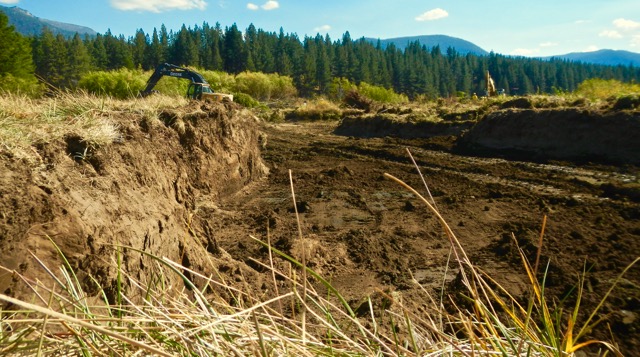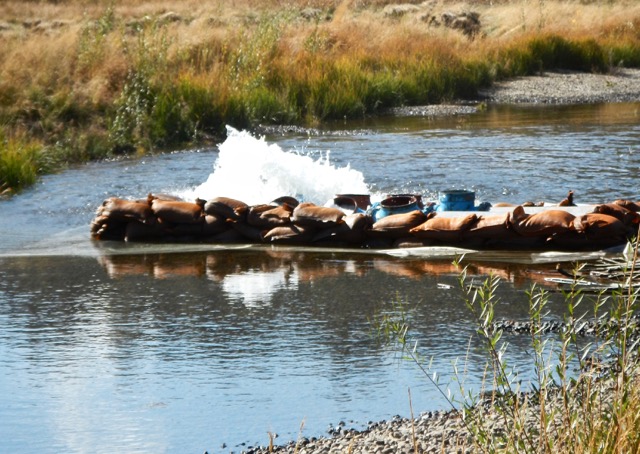Overbudget river project showing promise

The U.S. Forest Service is pleased with the restoration of the Upper Truckee River. Photo/Kathryn Reed
By Kathryn Reed
Rerouting the Upper Truckee River behind Lake Tahoe Airport is costing 50 percent more than planned and there is no way to know if less sediment will actually get carried into Lake Tahoe.
“It’s hard to make conclusions about the overall sediment reduction,” Theresa Cody, a hydrologist with the U.S. Forest Service, said while on a tour of the project site last week.
All along the USFS has said this is more of an ecosystem project than a water quality project. The California Tahoe Conservancy is a partner with the USFS.
In 2013, the feds said it would cost $4 million. The price tag is at $7 million now. The money is coming from the Southern Nevada Public Lands Management Act.
CTC Executive Director Patrick Wright was quick to say the added dollars aren’t because of cost overruns. Additional dollars were needed because it took longer than anticipated to reroute the 6,000-foot channel, then relocating the thousands of Western pearlshell mussels was not in the original budget, and a temporary construction bridge was erected and dismantled each season.

Dirt is excavated to subgrade, before the banks area revegetated, and riffle gravels are added to bring the river’s floor to the desired elevation. Photo/Kathryn Reed
The 14,000 native mussels were relocated this season.
“There is no scientific evidence or theory that we are aware of to suggest that changes in mussel populations have a measurable impact one way or the other on fisheries or benthic macroinvertebrates,” Cody said.
They do, however, filter out plankton, algae and small organic matter.
The overall fish habitat is expected to increase, especially with the riffle depth going from 9 feet to 3½ feet.
It will take years before the Forest Service can say this is a successful project. Monitoring will be extensive to begin with and then scaled back.
“We need large floods to see how the channel behaves and how the floodplain behaves,” Cody said. It’s designed to overflow its banks, which will then help restore the meadow to a vibrant organism.

Water is being pumped into the new channel. Photo/Kathryn Reed
But already positive results are coming in along sections of the 1.2-mile river project. Vegetation is taking hold on the banks, including the willows that love a wet environment. And next year the sage is apt to be gone because the water table will have increased and that plant doesn’t like a ton of water.
“There is no question that the existing condition of this reach was in a degraded and vulnerable condition, as evidenced by channel incision, bank erosion, ground water elevation, and riparian vegetation condition,” Cody told Lake Tahoe News. “The effects of long-term climate change, including prolonged periods of drought, is causing increased stress to the flora and fauna in these degraded systems. As evidenced by monitoring data we have documented in our monitoring reports on similar projects, the restoration of aquatic and riparian habitat is expected to be evident very quickly once the project is completed. The ecosystem benefits of the project are expected to last for generations, will increase resiliency of UTR habitat to climate change impacts, and require virtually no maintenance.”
The old channel saw the water rushing at 700 to 1,000 cubic feet per second. The new channel is designed to have a flow of 375 cfs.
Normally the Forest Service would leave the old channel to pond and become more habitat. But the FAA said no way, it must be filled in with dirt. This is because the project was not allowed to create more areas for waterfowl to congregate; after all birds and planes don’t mix well.
This area is popular for hikers, dog walkers and mountain bikers. Before the snow really flies, all of the construction equipment will be gone and the fences will come down. Next spring non-motorized water enthusiasts may find a more challenging river because it will be narrower. The season may last longer, too, because the water will be deeper – assuming there is at least a normal snowfall.
“Within two years you will not be able to see this area was disturbed,” Cody said.


